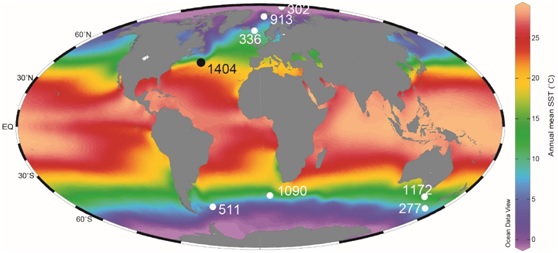A research article about Paleogene sea surface temperature (SST) changes appears in this week’s (July 16, 2018) Advance Online Publication on Nature Geoscience’s website. In this paper, reconstructed SST changes from 43 million years ago (Ma) to 18 Ma were reported, showing that North Atlantic SST did not immediately cool down when Antarctic continental ice started to develop around 34 Ma.
The Paleogene (65-23 Ma) is an important period in Earth’s climate history. Existing incomplete temperature records suggest that the climate was exceptionally warm. For a long time, Earth’s continents were ice-free. During the Eocene-Oligocene Transition (EOT) around 34 Ma, permanent continental ice sheets started to occur on Antarctic, after the long-term gradual global cooling during the Eocene, while Greenland ice sheets in the Northern Hemisphere did not occur until ~3 Ma. Approximately around the EOT time, due to tectonic movement, oceanic gateways around Antarctic also opened up, leading to the speculation that land-ocean distribution, oceanic circulation system and ocean water column structure at the time were roughly similar to their modern form.
In the modern ocean circulation system, the Atlantic Meridional Overturning Circulation (AMOC), which flows from the South Atlantic to the North Atlantic, across the Equator, at the surface ocean and returns to the Southern Ocean at the deep ocean, plays an important role in abrupt climatic changes. For instance, the health of Asian monsoon circulation, which billions of people live upon, is believed to be closely associated with AMOC changes through atmospheric and/or oceanic bridges. Therefore, the controlling factors on the AMOC and the projection of future AMOC evolution have been a hot topic in oceanography and global climate change studies. However, it remains controversial which, the deep water formation in the North Atlantic or the upwelling in the Southern Ocean, plays a more important role in facilitating the AMOC. It also remains unclear how the early AMOC evolved into its present form.
In this study, authors reconstructed SST changes, for the first time, over a long 25-million-years period, from 43 Ma to 18 Ma, utilizing the newly retrieved 200 m sediment core from the Newfoundland Ridge in the North Atlantic Ocean in 2012 by Integrated Ocean Discovery Program (IODP), which includes climate information from the critical EOT interval. Their SST record confirms the exceptional warmth during the Paleogene period. They have found that the 25°C isotherm was positioned ~15° latitude (>1,500 km) to the north of its modern position. Further, their SST record shows that SST fluctuations during most of the studied period is consistent with deep water temperature changes, as indicated by the oxygen isotopes of benthic calcites. However, their SST record also demonstrates an important anomaly. Over a 2-million-year period (~34-32 Ma) around the EOT, North Atlantic Ocean shows little contemporaneous surface cooling associated with the Antarctic ice sheets formation when the Southern Ocean appeared to have cooled substantially. The distinct decoupling of temperature changes between hemispheres suggests that changes in ocean circulation and meridional heat transport were important across the EOT, perhaps triggering the development of modern-like AMOC.
This study was conductedby researchers from University of Hong Kong, Institute of Earth Environment, Chinese Academy of Sciences, Zhejiang University and University of Southampton, and supported by MOST, NSFC, CAS, HK RGC, UK NERC and IODP China Office. Research samples were provided by IODP.
Nature Geoscience is thanked for providing related information.
Contact person: Dr. Zhonghui Liu(email: zhliu@hku.hk).

Location map for this study, with present study site indicated with black and locations of previous studies indicated with white(Image by LIU Zhonghui et al.)
 © 2015 Institute of Earth Environment,CAS
© 2015 Institute of Earth Environment,CAS Address:No. 97 Yanxiang Road, Xi'an 710061, Shaanxi, China

 Location :
Location :